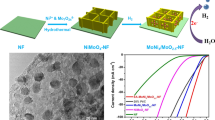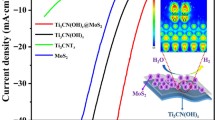Abstract
Surface modification of electrocatalyst suitable for yielding reduced overpotential with improved exchange current density at the interface is highly desired for hydrogen evolution reaction (HER). Herein, the present report demonstrates the HER performance of ordered mesoporous carbon (OMC)-supported nickel-modified \(\hbox {MoS}_{\mathrm {2}}\) electrocatalysts [NiMoS(x)–OMC] synthesized by hydrothermal route. Inherent activity of pristine \(\hbox {MoS}_{\mathrm {2}}\) was improved by two vital surface strategies utilizing OMC as the support matrix for the dispersed growth of active catalyst and surpassing the active sites formation via augmentation of various concentrations of nickel. Crystalline phase, heterostructure vibrations, morphological orientation and electrocatalytic property of the prepared catalysts are comprehensively studied using different spectroscopic methods. Linear sweep voltammetric analysis suggests that the HER from the pristine \(\hbox {MoS}_{\mathrm {2}}\) could be amplified by introducing OMC as support matrix. Synergistic enrichment of Ni (3 and 5 wt%) on \(\hbox {MoS}_{\mathrm {2}}\)–OMC matrix enables both the lowest onset potential (180 and 185 mV) and Tafel slope values (103 and 100 mV per decade), with retained stability promising for further optimization and scalability.






Similar content being viewed by others
References
Alex C and Donald W K 2018 Energy Econ.70 179
Omar E, Haitham A R and Frede B 2014 Renew. Sust. Energ. Rev.39 748
Panwar N L, Kaushik S C and Surendra K 2011 Renew. Sust. Energ. Rev.15 1513
Dresselhaus M S and Thomas I L 2001 Nature414 332
John A T 2004 Science305 972
Wei-Fu C, James T M and Etsuko F 2013 Chem. Commun.49 8896
Peng X, Wei C and Xin W 2015 Adv. Energy Mater.5 1500985
Min-Rui G, Yun-Fei X, Jun J and Shu-Hong Y 2013 Chem. Soc. Rev.42 2986
Nasir M, Yunduo Y, Jing-Wen Z, Lun P, Xiangwen Z and Ji-Jun Z 2018 Adv. Sci.5 1700464
Peitao L, Jingyi Z, Jingyan Z, Kun T, Daqiang G and Pinxian X 2018 Electrochem. Acta260 24
Thomas F J, Kristina P J, Jacob B, Jane H N, Sebastian H and Chorkendorff I B 2007 Science317 100
Xiaoping D, Kangli D, Zhanzhao L, Hui S, Ying Y, Wen Z et al 2015 Int. J. Hydrog. Energy40 8877
Yanguang L, Hailiang W, Liming X, Yongye L, Guosong H and Hongjie D 2011 J. Am. Chem. Soc.133 7296
Weijia Z, Kai Z, Dongman H, Xiaojun L, Guoqiang L, Yuanhua S et al 2014 ACS Appl. Mater. Interfaces6 21534
Thomas R H, Jakob K, Charlie T, David W P, Laurie A K, Frank A-P et al 2017 ACS Catal.7 7126
Jie Z, Wenchao S, Zhongbin Z, Bingjun X and Yushan Y 2016 Sci. Adv.2 e1501602
Julien D, Christoph S, Frédéric H and Hubert A G 2015 J. Electrochem. Soc. 162 190
Jie P, Changsheng S, Xin W, Xiaotao Y, Yuqiang F, Chenguang G et al 2017 Inorg. Chem. Front.4 1895
Xucai Y, Haifeng D, Gang S, Wu Y, Ailing S, Qinghua D et al 2017 Int. J. Hydrog. Energy42 11262
Swathi M, Md A W, Luqman A, Muxina K and Jorge B 2019 RSC Adv.9 17194
Xing Z and Yongye L 2018 Adv. Sci.5 1700644
Jiamu C, Jing Z, Yufeng Z, Yuxi W and Xiaowei L 2018 ACS Appl. Mater. Interfaces10 1752
Jian Z, Tao W, Pan L, Shaohua L, Renhao D, Xiaodong Z et al 2016 Energy Environ. Sci. 9 2789
Chengdu L, Zuojiang L and Sheng D 2008 Angew. Chem. Int. Ed.47 3696
Elodie B, Pavel A, Gilles B, Denis U and Stephane L 2016 C.R. Chimie19 1310
Dezhi W, Xiangyong Z, Yilin S and Zhuangzhi W 2016 RSC Adv. 6 16656
Xiaoyan M, Jinquan L, Changhua A, Juan F, Yuhua C, Junxue L et al 2016 Nano Res.9 2284
Dario M, Paul T, Laura C, Tomasz K, Denis G, Doriana D et al 2019 Surfaces2 531
Acknowledgements
Suresh thanks CSIR-CECRI in-house start-up scheme (Grant No: IHP-0091), CSIR Network Project (M2D, CSC 0134), Fast track Translational project (MLP-0102) and Central Instrumentation Facility Division of CSIR-CECRI.
Author information
Authors and Affiliations
Corresponding author
Rights and permissions
About this article
Cite this article
Viji, P., Bharkavi, S., Vijayan, P. et al. Strategy for enhancing the hydrogen evolution reaction properties of \(\hbox {MoS}_{\mathrm {2}}\) by utilizing the ordered mesoporous carbon as support and modification with nickel. Bull Mater Sci 43, 145 (2020). https://doi.org/10.1007/s12034-020-02133-3
Received:
Accepted:
Published:
DOI: https://doi.org/10.1007/s12034-020-02133-3




